This article was published in Scientific American’s former blog network and reflects the views of the author, not necessarily those of Scientific American
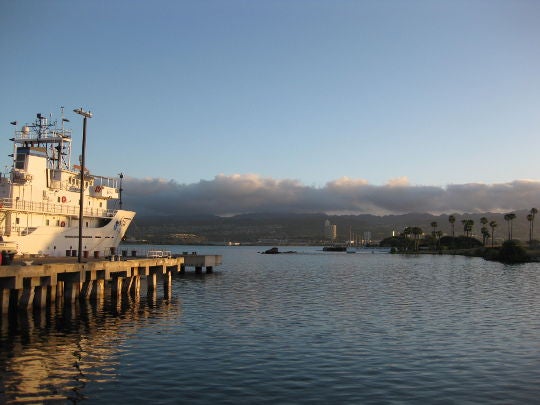
Pearl Harbor, Dawn. Credit: Jennifer Frazer
I happened to be in Hawaii last month at the same time that the National Oceanic and Atmospheric Administration(NOAA)'s ship of exploration, the Okeanos Explorer -- of live-streaming, ocean-esplorin’ fame -- was docked in Pearl Harbor. There are several ships that do that, but only one belongs to the American people. This one.
On a whim, I wrote to see if I might get a tour of the ship while I was around. Considering the events of the last few weeks, I’m glad I did it while I had the chance. I got to see NOAA Mission Control, the bridge, and the ship’s faithful ROVDeep Discoverer (nicknamed D2)… sort of. When on board, it lives under a protective cover inside a garage. But I was so close to the sampling baskets on the front that I could have reached out and touched one. And I’m kinda sorry now I didn’t!
On supporting science journalism
If you're enjoying this article, consider supporting our award-winning journalism by subscribing. By purchasing a subscription you are helping to ensure the future of impactful stories about the discoveries and ideas shaping our world today.
Anyhow, if you’re a regular reader of this blog you’re no doubt aware that I am a booster for ocean exploration. I regularly argue it is every bit as important – perhaps more -- as exploring space. This is our home, after all, and exoplaneteers notwithstanding, it’s the only one we’ve got. I’ve often featured clips from the voyages of the Explorer here on my blog, and I’ve spent hours watching their live feed as they explore strange new worlds, seek out new life and new ecosystems, and boldly go where no one has gone before. ‘Cause that’s their actual job.
Here she is the morning I saw her, which happened to be Martin Luther King Jr. Day.
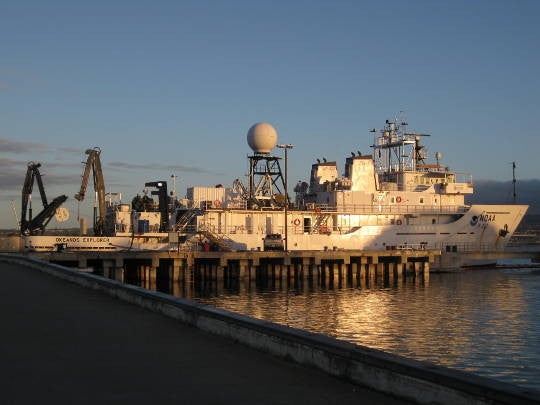
Credit: Jennifer Frazer
That actually presented a problem in getting me in to a military base on a holiday, but fortunately an employee of the Pacific Tsunami Warning Center (also located in Pearl Harbor) offered to give me a lift. Thank you kind sir!
I was met by MeMe Lobecker and Mike White, physical scientists and hydrographers who work on the Explorer's mapping projects.
Here is the "Wet Lab":
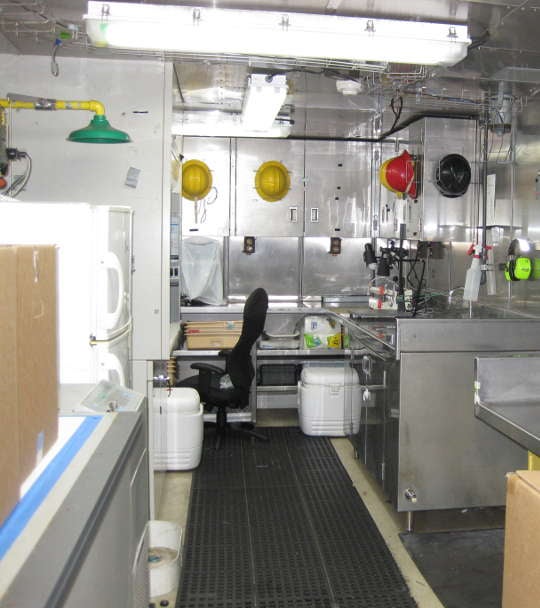
Credit: Jennifer Frazer
It's long and skinny. On the left is a fume hood for sousing specimens in preservative chemicals. On the right toward the rear are dissection lights. On the floor are coolers for the preserved specimens. Can you imagine staring into a microscope here with the smell of formalin in the air (the fume hood never gets it all) while the ship pitches and rolls? Paging Dr. Dramamine.
The samples add up fast. Deep Discoverer can retrieve two to three biological samples per dive, so they may end up with around 40 samples by mission end. All those specimens must be properly preserved and documented.
By the end of the expedition, Lobecker said, they may also have several hundred pounds of rocks, which have the advantage of needing significantly less dissection and preservation. [Seasick biologists give geologists a slanty eyed side squint]
The spirit of Star Trek really does permeate this ship -- and at the captain's behest, no less, according to Lobecker. Here, for example, is the door to Mission Control:
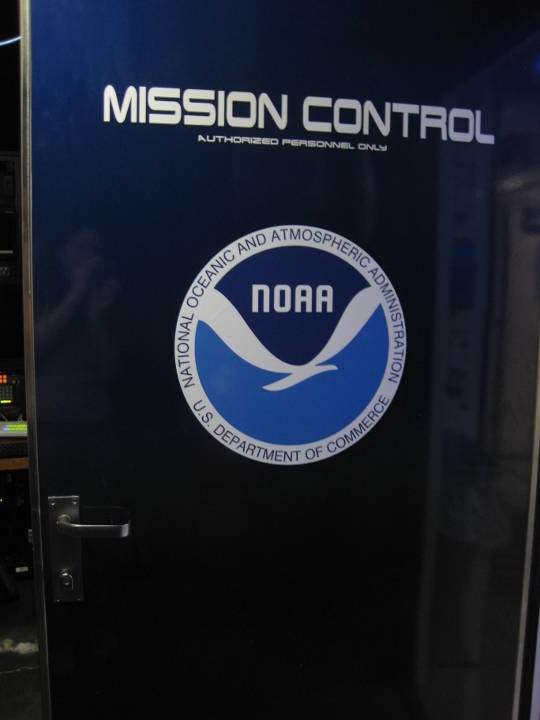
Credit: Jennifer Frazer
While we were there, we heard this sound followed by a message about an upcoming drill. Do you know it? It's the intercom whistle from the original Star Trek TV series. When he came aboard, the current commanding officer asked for the ship to sound like Star Trek, and the crew Made It So.
Here is Okeanos Explorer Mission Control. Everything is swathed in black.
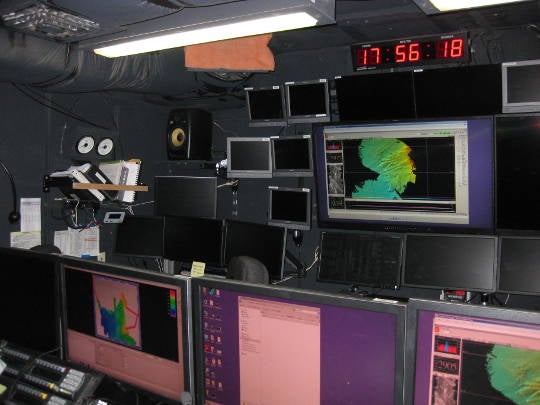
Credit: Jennifer Frazer
Here is the front row where the ROV pilot and copilots sit. And those wooden boxes, buttons, and joysticks, my friends, are how you drive an ROV.
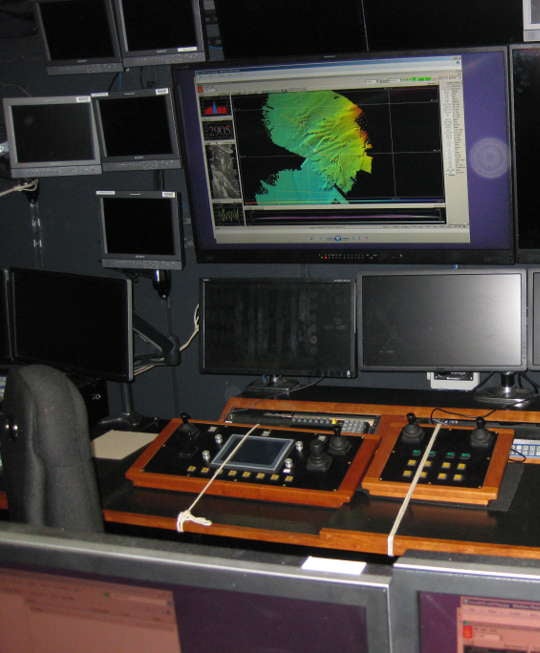
Credit: Jennifer Frazer
Note the ropes, which I assume are battening mechanisms to prevent those control panels from going anywhere unauthorized while at sea.
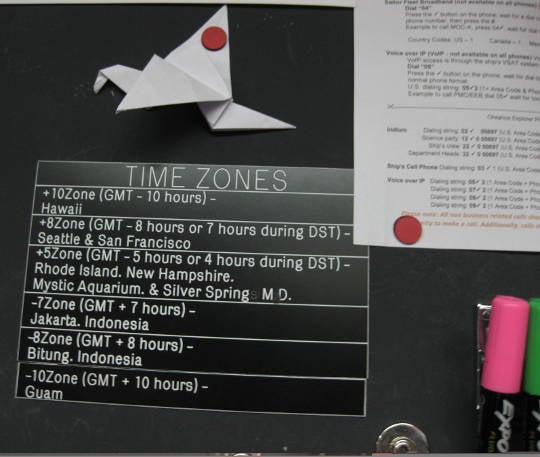
Credit: Jennifer Frazer
Long hours at sea probably provide ample time for the fashioning of a lucky crane ...
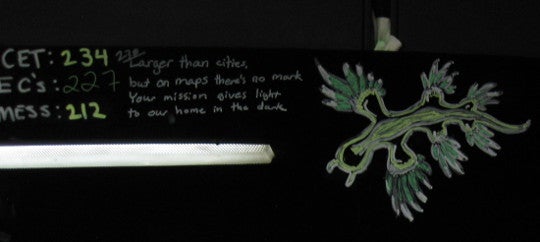
Credit: Jennifer Frazer
...or for the drawing of the ocean invertebrate Glaucus atlanticus, which I wrote about on this blog long ago. This one was spotted on a black dry erase board at the back of Mission Control. Note also the poem, which I assume is an original composition by one of the crew or science team, since a google search turned up nothing like it on the interweb. In case you can't read it, it says,
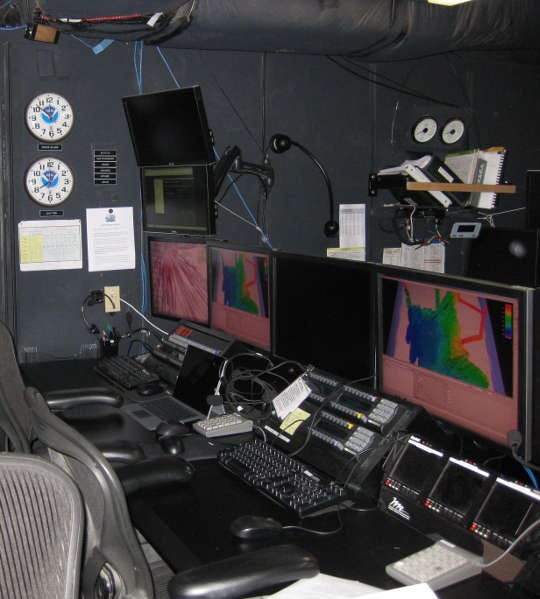
Credit: Jennifer Frazer
Larger than cities,
but on maps there's no mark
Your mission gives light
to our home in the dark
Here is the back row where the mission scientists sit. There are usually two or three, and they chat with dozens of participating scientists on shore as the mission unfolds. There is a mere two second delay between the observations of Deep Discoverer on the bottom of the ocean and their appearance on the screen at mission control, while only five to ten seconds separates what D2 sees from what scientists in America see (where they may sitting up in their jammies in the middle of the night).
The three scientists listen to what the shore-side scientists are telling them seems interesting or worth investigating, confer among themselves, and then tell the ROV pilots in the row in front of them what objects and critters should get a closer look.
Mapping, the line of work that Lobecker and White are in, although not as sexy in this biologist's opinion as ROV diving, is another of the ship's missions and among the most important. As recently as 2000, up to 95% of the ocean remained unexplored. Lobecker told me scientists have estimated that in the Pacific Ocean there are over 100,000 seamounts -- underwater peaks rising in excess of 1,000 meters from the seabed -- that remain unmapped by any modern equipment.
The Navy must be nettled by this, because they created something called the "Red Dot Program" in which they list seamounts they'd really love to have mapped if Okeanos Explorer, you know, ever happens to be in the neighborhood. Lobecker said she has no idea how the Navy picks them. "We don't ask," she said. "We just map."
Any data generated by the ship, whether biological, geological, or cartographic, becomes available to the public. We paid for it, after all.
Going bow-ward from Mission Control through a hall lined with two to four person "state rooms" where the scientists live while at sea and up two flights of stairs (past the officers' quarters) brought me to the bridge. Here is the floor mat that greets you there.
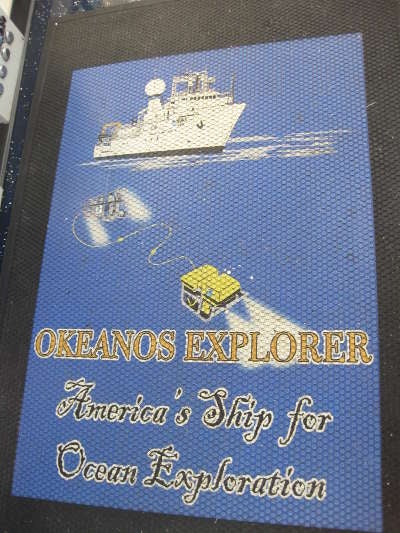
Credit: Jennifer Frazer
I also spotted this important control panel stuck to the wall toward the rear. I think half of America feels a desperate urge to hit that yellow button right now.
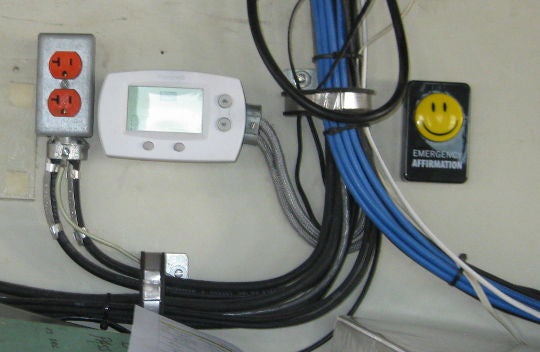
Credit: Jennifer Frazer
Here is where you drive the ship.
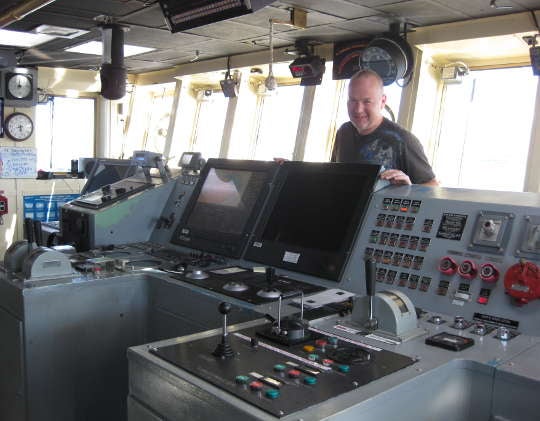
Credit: Jennifer Frazer
That machine Lt. Aaron Colohan is standing behind is an extremely expensive piece of equipment originally designed for oil tankers and supply ships called a "Dynamic Positioning System". It can hold the 2000-ton ship in position on the open ocean to within one meter. One meter! In theory, it's no more complex than the trolling motor on my dad's fishing boat, which can accomplish the same feat. In practice: probably a lot more complex. You can imagine how important the ability to nail the ship down, so to speak, might be if you've got a $3.5 million dollar ROV armed with Superbowl-quality cameras trying to do extreme close-ups while plucking delicate creatures from the seabed at the end of a 4,000 meter tether.
In high enough seas, the system will eventually fail. It is the captain and crew's job to determine when things are getting dicey enough that it's time to pull the ROV out of the pool. Extraction takes a mere two hours if the ROV is at 4,000 meters, so they'd better choose well.
It could be even longer, since D2's max depth is 6,000 meters, much deeper than the 3,700 meter average depth of the ocean. To put that in perspective, 6,000 meters is nearly 20,000 feet -- 6,500 feet or so higher than the elevation of the tallest mountain in Colorado -- and about four miles deep.
Without the dynamic positioning system, Colohan said, it would be impossible to do ROV dives unless the sea were like glass. The ROV itself can take a beating, but the delicate instruments on it not so much.
This is the most important feature on the ship: the captain's chair.
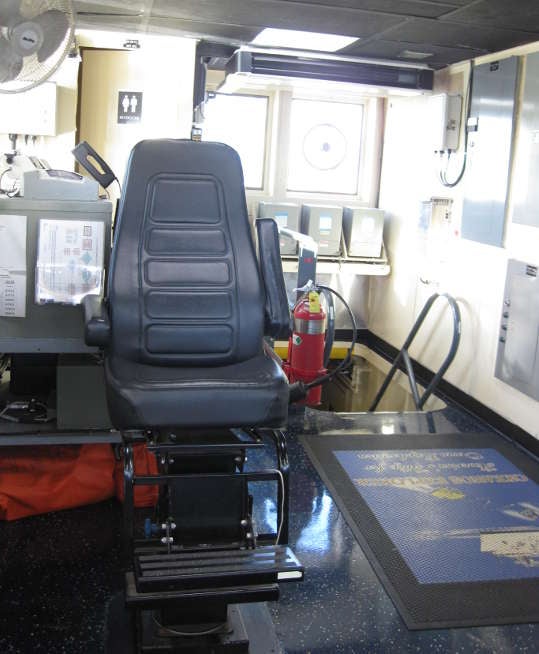
Credit: Jennifer Frazer
I note that it lacks cup holders. I saw an uncannily similar one on the bridge of the USS Missouri, also docked in Pearl Harbor. I guess Naval captain's chair technology has not advanced much in 70 years. I also note the convenient proximity of the equal-opportunity toilet. Which is better than the House of Representatives could say, until recently.
This is the antenna farm, way up at the top there.
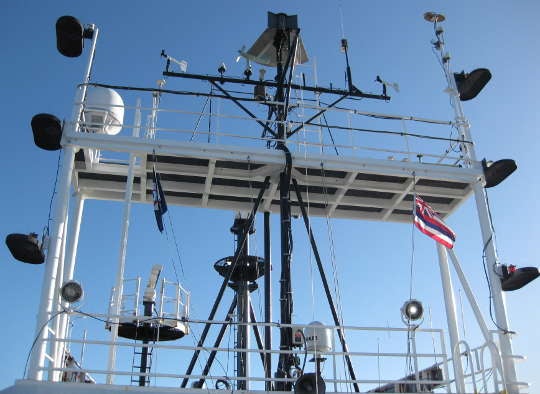
Credit: Jennifer Frazer
Lobecker said that sometimes when they notice they're getting screwy data, they go out to have a look at the farm and there's a bird standing on it.
Note also the Hawaii flag.
This is how you get internet at sea:
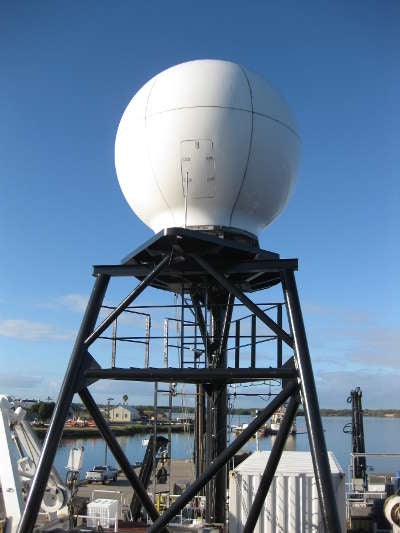
Credit: Jennifer Frazer
It's called the VSAT bubble, and there's a tracking antenna in there that moves as the ship pitches and rolls to stay locked on to the nearest satellite 25,000 miles above. This antenna also beams the ship's data to shore.
Here we have Deep Discoverer's camera sled Seirios. They are joined by a tether. Seirios hovers over D2 like a big brother, keeping an eye on the ROV and offering a wider perspective on the scene to the ROV pilots and scientists. As I mentioned, it's wearing its PJs.
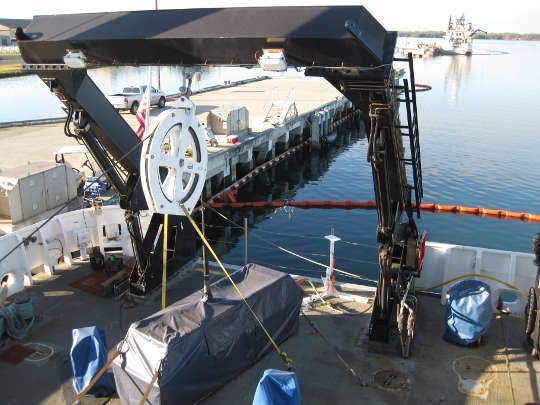
Credit: Jennifer Frazer
Here's what it looks like while at sea:
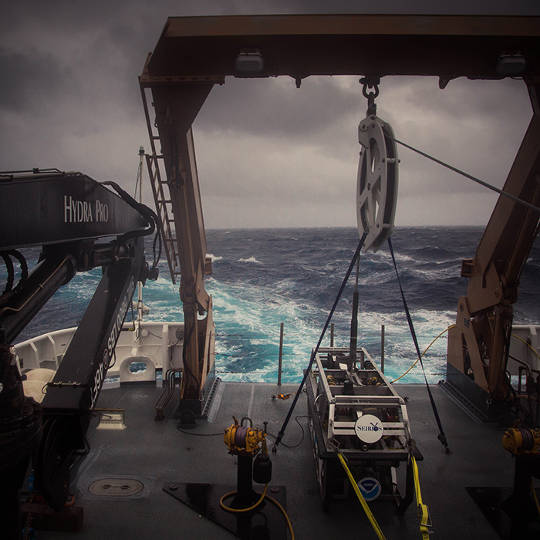
This is the crane used to catch and release Deep Discoverer.
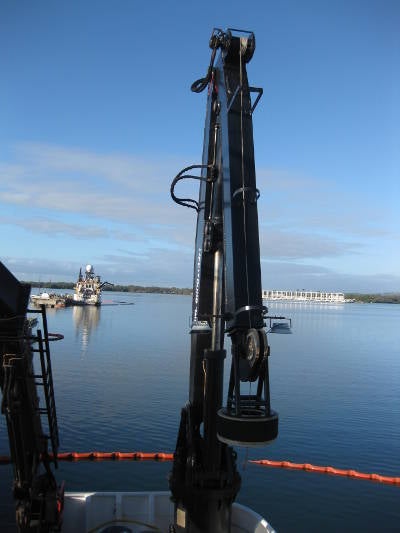
Credit: Jennifer Frazer
On the end is a truck tire that has been repurposed as a "swing arrestor". When Deep Discoverer is hauled in, it hits that tire which dampens any lateral motion and allows the ROV to be more safely deposited on deck.
Here's what it looks like (note the obvious treads on the tire):
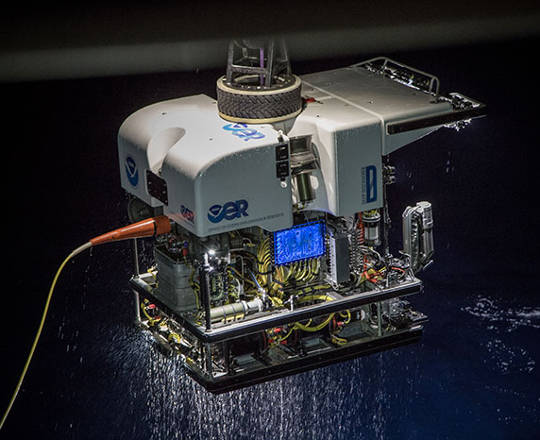
Here it is from the front:
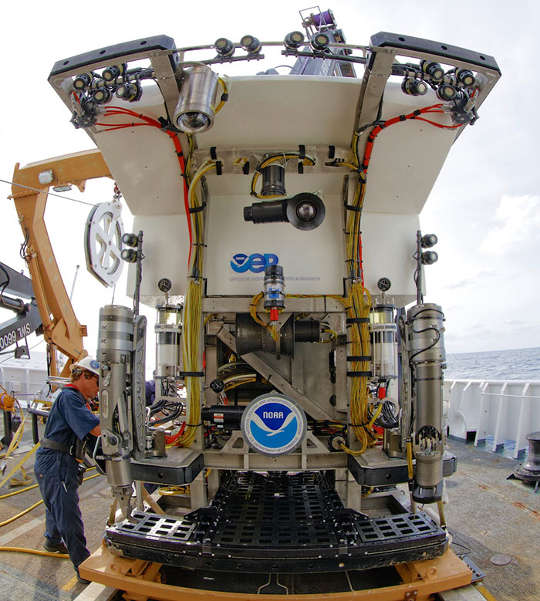
Unfortunately, I wasn't able to see Deep Discoverer uncovered either. But seeing it in person, even covered, did enable me to make one observation. The ROV is enormous! It's the size of a large room...
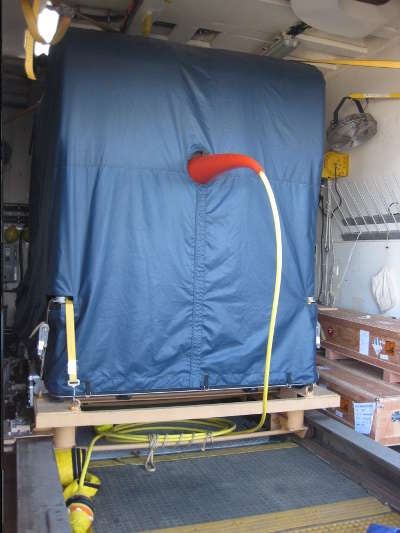
Credit: Jennifer Frazer
... and much bigger than the dinky ROVs I've seen in the movies. In this image, the row of hard hats in the background should give you the scale.
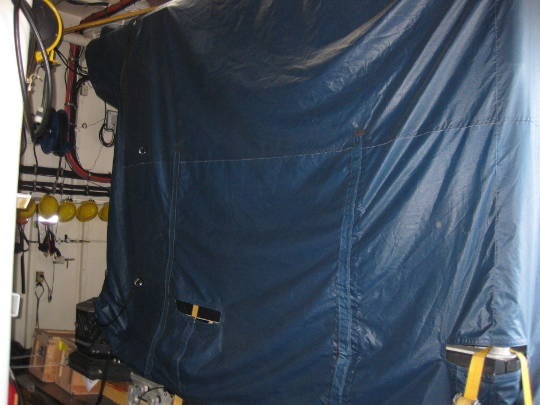
Credit: Jennifer Frazer
On the bottom left you can see the rugged plastic biological specimen collection basket. That is the one I got to stand next to and could have reached out and touched. On the right side of the ROV is a similar looking rock box. Lobecker observed that rocks that look small on camera frequently emerge from the ocean not so wee. I guess Objects in Camera Are Larger Than They Appear.
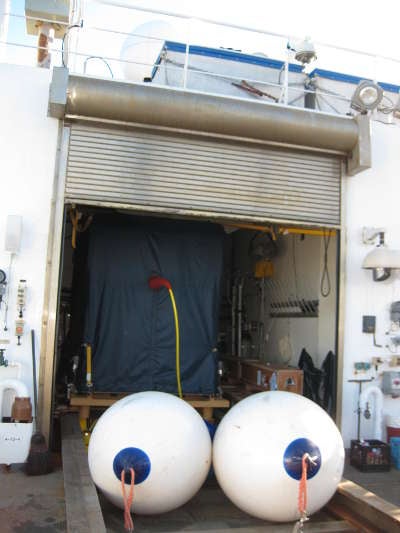
Credit: Jennifer Frazer
Here is D2 in its garage. You can see the railroad that can be used to slide it in and out. No comment on the enormous ... buoys.
.JPG?w=540)
Credit: Jennifer Frazer
Thus ended my tour. I asked my guides what their most surprising, scary, or favorite moments aboard Okeanos Explorer had been. Lobecker recalled a time that oil workers alerted them to a suspected shipwreck of potential archaeological importance. To their surprise, they encountered a nine-foot wide asphalt extrusion/artform on the bottom of the Gulf of Mexico. Only one or two such structures had ever been seen in the world before -- and not in the gulf -- and they had never even been given a name. They dubbed it the "tar lily".
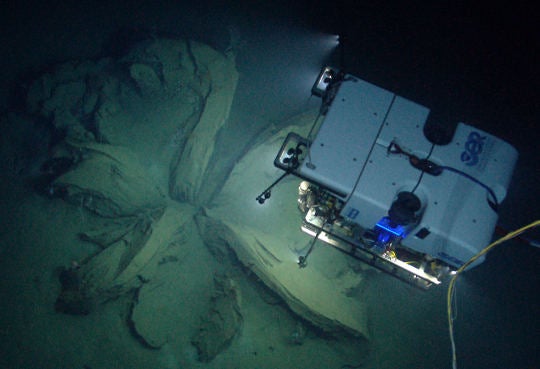
White recalled retrieving a device intended to measure the speed of sound in local water -- a shiny silver probe at the end of a long line. To the crew's shock, just as they were pulling it out, a nine-foot swordfish leapt from the water, no doubt perturbed the lunch it had tracked all they way back to the ship had somehow made a miraculous escape. The crew was pleased the swordfish hadn't chomped it first. "What are you going to do [if] you hook a 2,000 pound fish that pulls 10,000 pounds?" White observed.
But more mundane moments aboard Explorer also have the abiity to thrill. Nighttime Deep Discoverer retrievals are popular spectator events aboard ship, Lobecker said, as a glow gradually suffuses the deep before the whole contraption is hoisted dripping and lights ablaze to deck. It must be magical.
Space is not the final frontier, at least not yet. Nor is it the only one still capable of inspiring surprise and wonder. Let us not, in our understandable haste to reach for the stars, forget that.
You can follow the explorations of Okeanos Explorerhere. The live-streaming feed for their current Pacific cruise is here. Check it out!